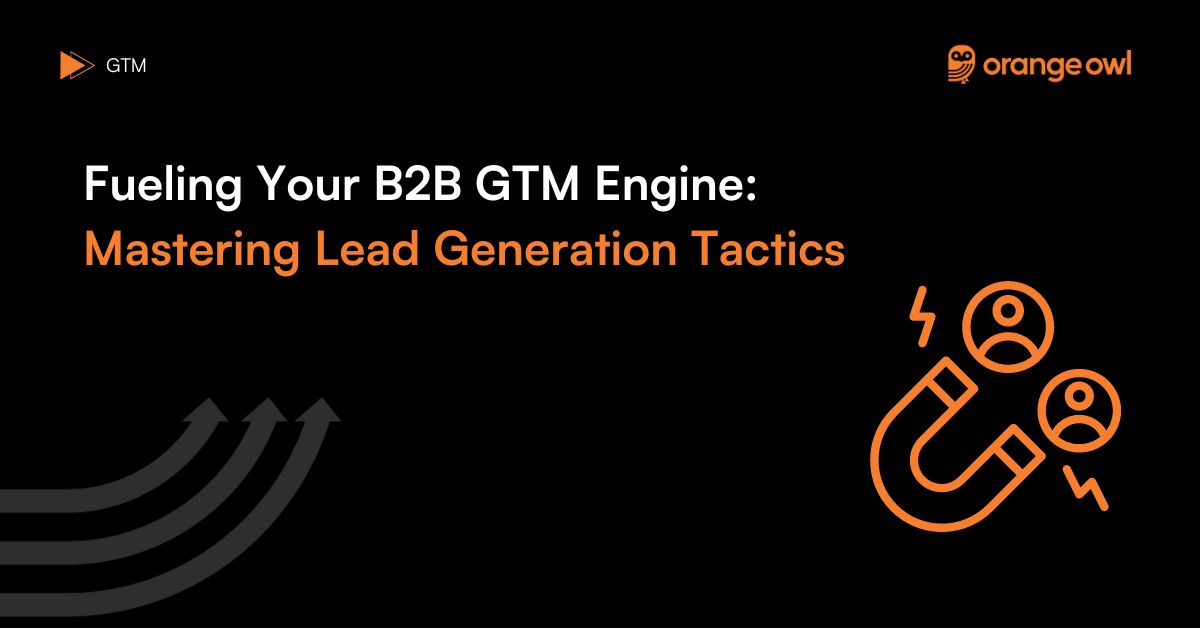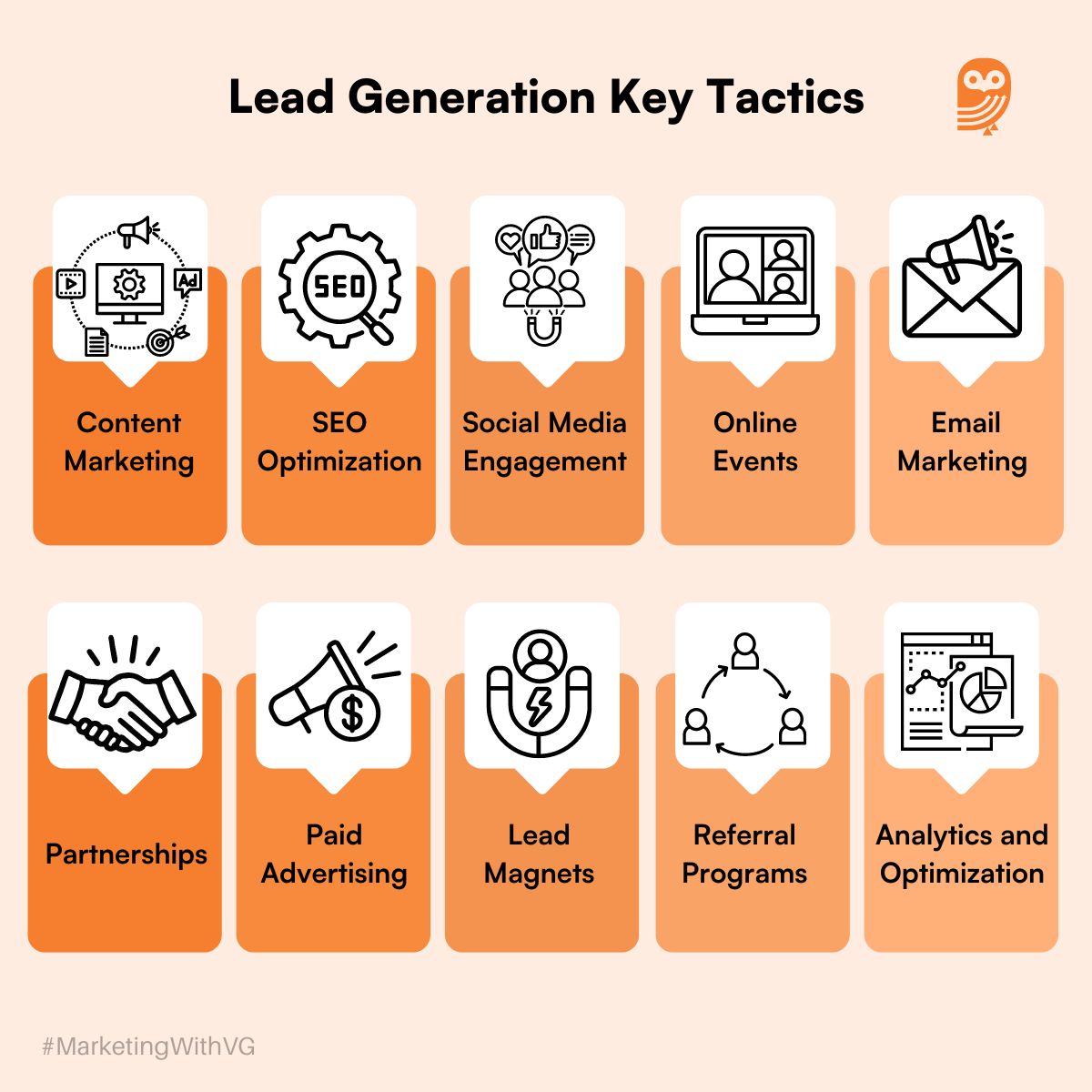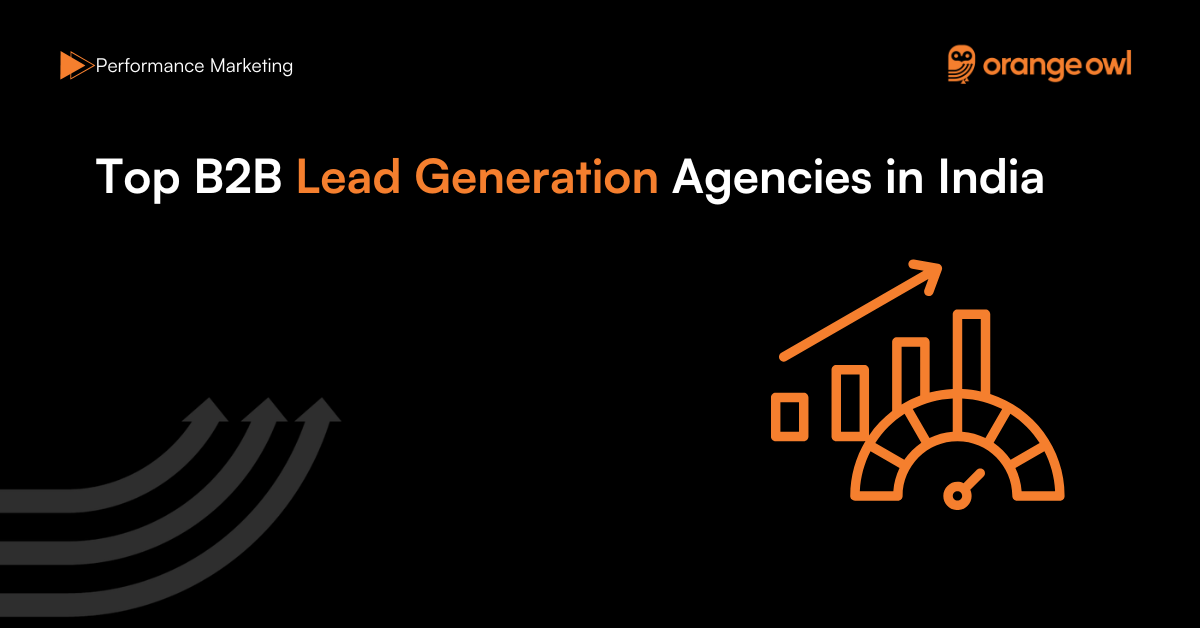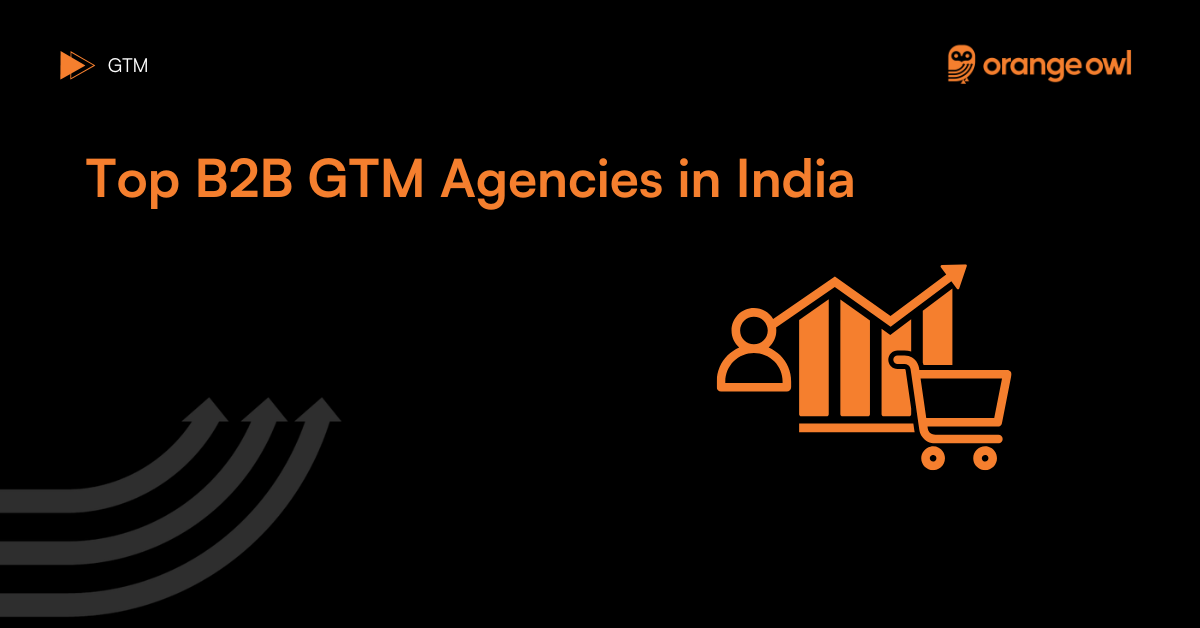Fueling Your B2B GTM Engine: Mastering Lead Generation Tactics
Orange Owl
February 1, 2025

Table of Contents
In today’s rapidly evolving business landscape, mastering lead generation is a cornerstone of success for B2B enterprises. As businesses strive to expand their market presence, drive revenue growth, and outmaneuver competitors, effective lead-generation strategies have become indispensable. However, in the complex ecosystem of B2B sales and marketing, lead generation is not merely a standalone activity but an integral part of a comprehensive Go-To-Market (GTM) strategy.
Understanding Lead Generation in GTM Strategies

At its core, lead generation within the GTM framework involves the systematic process of identifying, nurturing, and converting potential customers into qualified leads. Unlike traditional approaches that focus solely on acquiring new leads, GTM-aligned lead generation strategies prioritize the seamless integration of sales, marketing, and customer engagement efforts to drive meaningful outcomes at every stage of the buyer’s journey.
The Role of Lead Generation in GTM Strategies
Lead generation serves as the lifeblood of GTM strategies, facilitating the following key objectives:
- Market Penetration and Expansion: By targeting specific market segments and buyer personas, lead generation initiatives enable businesses to penetrate new markets, expand their customer base, and capitalize on emerging opportunities.
- Customer Acquisition and Retention: Lead generation efforts play a crucial role in acquiring new customers while also nurturing existing relationships to foster long-term loyalty and retention.
- Revenue Growth and Market Share: Effective lead generation contributes directly to revenue growth by driving sales conversions, increasing deal velocity, and capturing a larger share of the market.
- Brand Awareness and Thought Leadership: Through thoughtfully crafted content, engagement strategies, and industry partnerships, lead generation enhances brand visibility, establishes thought leadership, and reinforces brand positioning within target markets.
Essential Tactics for B2B Lead Generation
Within the GTM context, several tactics and strategies are instrumental in driving successful lead-generation campaigns:
Content Marketing
Content marketing remains a cornerstone of lead generation, leveraging valuable assets such as blog posts, whitepapers, eBooks, and case studies to educate, inform, and engage target audiences. By addressing specific pain points, industry challenges, and customer needs, content marketing establishes credibility, builds trust, and cultivates relationships with potential leads.
SEO Optimization
Search Engine Optimization (SEO) plays a critical role in driving organic traffic, enhancing online visibility, and attracting qualified leads to business websites. By optimizing website content, metadata, and technical elements for relevant keywords and search queries, businesses can improve their search engine rankings, increase website traffic, and capture the attention of potential customers actively seeking solutions.
Social Media Engagement
Social media platforms serve as dynamic channels for engaging with prospects, fostering community interactions, and amplifying brand presence. Within the GTM framework, social media engagement tactics involve leveraging platforms such as LinkedIn, Twitter, Facebook, and Instagram to share valuable content, initiate conversations, and build relationships with target audiences. By participating in industry discussions, hosting live events, and sharing compelling visual content, businesses can create meaningful touchpoints that resonate with potential leads and drive engagement.
Webinars and Online Events
Hosting webinars, virtual conferences, and online events provides businesses with unique opportunities to showcase expertise, deliver value-added content, and engage directly with potential customers. As part of GTM-aligned lead generation strategies, webinars serve as interactive platforms for educating prospects, addressing pain points, and demonstrating the value proposition of products or services. By leveraging webinar registrations, attendee engagement metrics, and post-event follow-ups, businesses can identify qualified leads, nurture relationships, and drive conversions effectively.
Email Marketing
Email marketing remains a powerful tool for lead nurturing within the GTM framework, enabling businesses to deliver targeted messages, personalized offers, and relevant content directly to prospects’ inboxes. By segmenting email lists based on demographic data, behavioral insights, and engagement levels, businesses can tailor their messaging to address specific needs, interests, and pain points of potential leads. Through automated drip campaigns, personalized communications, and strategic follow-up sequences, businesses can nurture leads effectively, move them through the sales funnel, and ultimately drive conversions.
Partnerships and Collaborations
Strategic partnerships and collaborative initiatives play a crucial role in expanding reach, accessing new markets, and driving mutual growth within the GTM framework. By forming alliances with complementary businesses, industry influencers, and strategic allies, businesses can leverage existing networks, share resources, and co-create value-added solutions that resonate with target audiences. Whether through co-marketing campaigns, referral programs, or joint ventures, partnerships offer opportunities to amplify brand visibility, generate qualified leads, and accelerate revenue growth.
Paid Advertising
Paid advertising channels, such as Pay-Per-Click (PPC) campaigns, display ads, and social media promotions, complement organic lead-generation efforts by providing targeted reach, precise audience segmentation, and measurable ROI. Within the GTM context, paid advertising tactics involve leveraging platforms like Google Ads, LinkedIn Ads, and Facebook Ads to deliver customized messages, drive traffic to landing pages, and capture the attention of potential leads. By optimizing ad creatives, refining targeting parameters, and monitoring campaign performance metrics, businesses can maximize the effectiveness of paid advertising campaigns and achieve desired outcomes.
Lead Magnets and Incentives
Offering valuable incentives, lead magnets, and gated content serves as an effective strategy for capturing contact information and qualifying leads within the GTM framework. Whether through downloadable resources, free trials, or exclusive offers, businesses can entice prospects to take desired actions, such as subscribing to newsletters, requesting demos, or signing up for product trials. By aligning lead magnets with the specific needs, interests, and pain points of the target audience, businesses can create compelling offers that drive engagement, conversions, and long-term customer relationships.
Integration with GTM Strategies
Lead generation tactics are seamlessly integrated into the broader GTM framework, aligning with each stage of the customer journey, from initial awareness to final conversion:
- Awareness Stage: At the awareness stage, lead generation efforts focus on attracting the attention of potential customers, raising brand awareness, and stimulating interest in products or services. Content marketing, social media engagement, and SEO optimization play key roles in generating top-of-funnel leads, driving website traffic, and capturing the attention of target audiences.
- Consideration Stage: As prospects progress through the consideration stage, lead generation tactics shift towards providing value-added content, addressing specific pain points, and establishing credibility and trust. Webinars, thought leadership articles and email marketing campaigns are deployed to nurture leads, educate prospects, and differentiate the brand from competitors.
- Decision Stage: At the decision stage, lead generation efforts focus on converting qualified leads into paying customers through personalized communications, targeted offers, and strategic follow-up sequences. By leveraging data insights, behavioral cues, and customer feedback, businesses can tailor their messaging, address objections, and guide prospects toward making informed purchase decisions.
Conclusion
In conclusion, mastering lead generation within the context of GTM strategies is essential for achieving sustainable growth, maximizing market reach, and outperforming competitors in today’s competitive business landscape. By adopting a strategic and integrated approach to lead generation, businesses can effectively attract, engage, and convert potential customers into loyal advocates, driving revenue growth, and market success. As technology continues to evolve, consumer behaviors shift, and market dynamics change, businesses must remain agile, and innovative to stay ahead of the curve.

Frequently Asked Questions about Lead Generation in GTM
Lead generation is crucial in a GTM strategy as it involves systematically identifying, nurturing, and converting potential customers into qualified leads. This process supports market penetration, customer acquisition, revenue growth, and brand awareness.
Content marketing drives lead generation by providing valuable and informative content that addresses the pain points and needs of target audiences. It helps build credibility, trust, and relationships with potential leads through blog posts, whitepapers, eBooks, and case studies.
SEO is vital because it enhances online visibility and drives organic traffic to business websites. By optimizing for relevant keywords and search queries, businesses can attract qualified leads who are actively searching for solutions.
Social media engagement helps by creating dynamic interactions with prospects, fostering community engagement, and amplifying brand presence. Platforms like LinkedIn, Twitter, and Facebook allow businesses to share valuable content, initiate conversations, and build relationships with target audiences.
Webinars offer a platform to showcase expertise, deliver value-added content, and engage directly with potential customers. They help identify qualified leads through registrations, engagement metrics, and follow-up communications.
Email marketing is effective for nurturing leads by delivering targeted and personalized messages. Through segmentation and automation, businesses can address specific needs and interests, moving leads through the sales funnel toward conversion.
Strategic partnerships and collaborations expand reach and access to new markets. By leveraging existing networks and co-creating value-added solutions, businesses can generate qualified leads and accelerate growth through co-marketing campaigns, referral programs, and joint ventures.
Paid advertising, such as PPC campaigns and social media ads, provides targeted reach and precise audience segmentation. It complements organic efforts by driving traffic to landing pages, capturing potential leads, and offering measurable ROI.
Lead magnets are valuable incentives offered to prospects in exchange for their contact information. Examples include downloadable resources, free trials, and exclusive offers. They entice prospects to take action, helping businesses capture and qualify leads
Intent data refers to information collected from various sources that indicates a potential buyer’s interest or intent to purchase a product or service. This data is crucial for B2B lead generation as it helps identify prospects who are actively researching or showing signs of interest in solutions similar to yours. By leveraging intent data, businesses can target leads who are more likely to convert, thus improving the efficiency and effectiveness of their GTM strategy.


